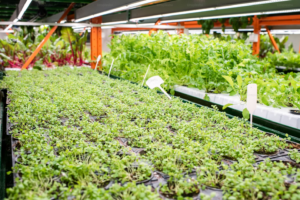Addressing Environmental Pollution
Nutrient Management – Dutch growers, who allowed nutrient-rich water to run from their farms, were contributing to chemical pollution and the increased incidence of water weeds in their canals and rivers. Strict laws were introduced to decrease this environmental pollution, by restricting the release of nutrient-rich water from production units.
Achieving Environmental Goals
Due to intensive research projects on recycling, they succeeded in reaching this goal in the year 2000. Two problems were solved in this process: The first was to monitor and adjust ions in the nutrient solution, and the second to sterilize the recycled solution. Sterilization options will be discussed in the next edition, allowing a few more words on the issue of plant nutrition here.

Sodium (Na) and Chloride (Cl) Accumulation
Prevent the accumulation of sodium (Na) and chloride (Cl). Feeding water with low Na and Cl levels must be used when nutrient solutions are recycled (closed system) in order to prevent the accumulation of these ions. The Dutch overcame this problem by building plastic lined reservoirs, filling them with rainwater from their glasshouse roofs. By mixing Na- and Cl-rich water with rainwater, the Na and Cl concentrations were lowered to safe levels.
Nutrient Levels for Different Crops

Since low EC crops such as roses can only absorb 5 ppm Na and 11 ppm Cl, these are the highest levels that may be allowed in the feeding water for roses in a 100% closed system. A saline-tolerant crop such as tomatoes can remove 16 ppm Na and 32 ppm Cl, allowing tomatoes to be recycled with feeding water containing these, or lower, Na and Cl levels. Should water with higher Na and Cl levels be used for a limited recycling period (until the red lights start flashing), saline-sensitive crops should be flushed as soon as root zone levels reach 69 ppm Na or 107 ppm Cl.
Nutrient Management for Greenhouse Crops
Most greenhouse crops will be unaffected with Na levels below 115 and Cl below 178 ppm. Saline-tolerant crops such as tomatoes will be able to withstand levels of up to 184 and 284 ppm Na and Cl respectively. Should these levels be exceeded, yield and quality losses will occur.
Adjusting Nutrient Levels
As a crop develops from the vegetative to reproductive stage, or with a change in climatic conditions, its nutritional needs change. The use of leaf deficiency or toxicity symptoms to identify nutritional problems is ineffective. It is impossible to avoid yield and quality losses with this approach, even by using quick petiole sap measurements as aid. The use of nutrient foliar sprays should not be necessary.
Root Zone Analysis for Nutrient Management

Root zone analyses, developed in the Netherlands during the last few years, can help growers to identify nutritional imbalances before it is reflected in the leaves and before damage can be done to the yield potential. This procedure is used by the Dutch and the Belgians, serving areas with high densities of growers. The laboratories send technicians to take root zone samples every week or two. The results and suggested changes to nutrient mixes are E-mailed to the growers the following day.
Adapting Principles for South Africa
The duplication of such a system under South African conditions may be impractical at this stage, but the same principles may be adapted to improve our nutrient managerial effectiveness. A root zone analysis is a must for recycling, but it can also be useful to optimize nutrition in a free-draining system. This procedure is described in the book: ‘Nutrient solutions and Greenhouse management’ only available from Dr. Nic Combrink: E-mail: njjc@sun.ac.za

